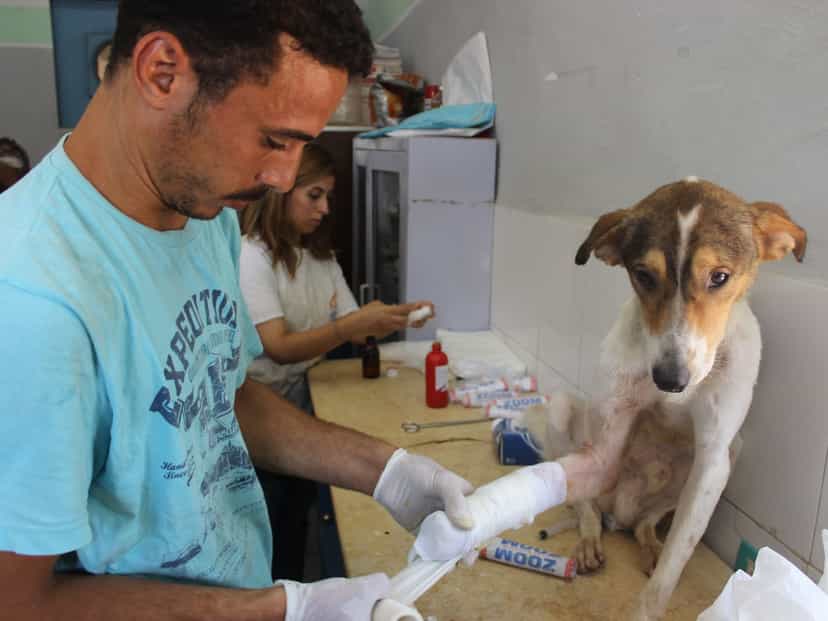
What creatures tend to bite our dogs during the warmer months? Is there anything I can do if my dog gets bitten? Will a insect bite have any effects on my dog? Dog first Aid Franchise Partner Kathy Hobson answers all of your interesting questions!
As the weather starts to warm up isn’t it lovely to be able to spend more time outdoors - topping up our vitamin D and lifting our mood? I’m actually sat in my garden while I write this, battling the glare of the sun on my computer screen but determined to ‘make the most’ of the lovely weather.
Unfortunately other creatures are emerging from their winter hideouts too! This is actually the riskiest time of year for our dogs to suffer bites and stings. Fleas and ticks are most prevalent at this time of year, bees and wasps are searching for food and mates, and snakes are warming themselves in the spring sunshine.
Of course, these creatures will generally try to avoid us as much as we try to avoid them. However, incidents can and do happen from time to time - imagine a dog sticking his nose into a bush or chasing a ball and not looking where he’s putting his feet. Bites and stings can be uncomfortable, painful and even occasionally life-threatening. Therefore it’s worth understanding a bit more about these biting beasts and what to do if your dog is bitten or stung.
Fleas
These are a common problem for our dogs though rarely more than an annoyance. Itching is the first and main symptom. Excessive scratching can cause inflammation and infection, and sometimes dogs can suffer from allergic dermatitis. A severe flea infestation can lead to anaemia due to the extent of blood loss as the fleas feed.
Keep up to date with flea treatment and check your dog regularly so that you can catch a problem early. Fleas can also carry tapeworm eggs so, if your dog does get fleas, you will need to treat for worms too. Fleas only hop on and off the dog to feed so most of them will actually be living in the dog’s bedding and your carpets – you’ll need to treat your house, and probably more than once due to the length of the flea’s lifecycle..
Ticks
Again, a fairly common annoyance. Ticks can carry many diseases and it’s possible for one tick to be carrying several at the same time. The most prevalent is Lyme Disease, although it’s actually still quite rare and generally less serious in dogs than in humans. That said, it is possible to cause damage to joints, kidneys, heart and nervous system. Watch for symptoms of swelling or pain in the joints and an elevated temperature, which can occur up to two months after infection.
Checking your dog regularly for ticks is important and so is the method of tick removal. Causing stress to the tick will likely cause it to regurgitate into the dog and increase the infection risk. Leaving it to fall off of its own accord will also increase the risk due to the length of time it is in the dog. You also don’t want to risk leaving the head/mouth parts behind which could result in an infection. The safest method of removing a tick is by using a tick twister/tick tool. They only cost a few pounds so are well worth the investment.

Bees & Wasps
My dog Freddie chases bees. I’m sure many of you reading this are nodding in agreement. They are extremely irritating to our dogs, who then can’t help themselves but to snap at them, however hard we try to teach them to ‘leave it alone’.
Bee and wasp stings are rarely any more than a painful spot for a couple of days. There are a few things to be cautious about though. If the sting is in the dog’s mouth it’s worth getting a vet to have a look. If you think the dog may have swallowed the bee or wasp then there may be stings in the throat which risk swelling and restricting the dogs airway. Dogs can also occasionally suffer an allergic reaction, see below.

Snakes
Grass snakes can bite but are not poisonous. The bite wound will be a bit sore but heal quickly. It’s worth using an antiseptic spray and monitoring the dog for a few days but there’s unlikely to be any complications.
Adder bites are a bigger problem because of their venom. Adders are recognisable by the dark diamond pattern down their backs. Symptoms to look out for (which you won’t get with a grass snake bite) are localised swelling at the bite site, vomiting, diarrhoea, drooling, panting, drowsiness and collapse. Severity will depend on how much venom has been injected into the dog and that also determines treatment.
Treatment will usually be antibiotics but in severe cases may be anti-venom. You will need to get the dog to the vet urgently, but carry them or move them slowly so that the venom doesn’t spread through the body any quicker than necessary. Call your vet first because they may direct you to another vet if they don’t stock the anti-venom themselves.

Allergy vs Anaphylaxis
Allergies to insect stings/bites will vary in severity, the more severe the reaction the less common it’s occurrence:
A mild allergy would present as lethargy, an elevated temperature and loss of appetite. This should resolve itself in a few days without any intervention but should definitely be monitored. Speak to a vet if you’re not sure, are concerned, or the dog seems to be getting worse.
A moderate allergic reaction would include, in addition to the above, redness, swelling, extreme itchiness, soreness and hives (multiple raised swellings). A vet should definitely be consulted because this can sometimes quickly progress to anaphylaxis which is life-threatening.
Anaphylaxis is a severe allergic reaction which affects the dog’s breathing and gastro/intestinal system. It is very rare but is life-threatening and will occur within an hour of the bite/sting, and usually within a few minutes. Symptoms will be dramatic: violent vomiting and/or diarrhoea, loss of balance, a drop in blood pressure which reduces the oxygen supply to the tissues and organs (shock), swelling in the airway which restricts breathing, seizuring and collapse. This is obviously an emergency and the dog must be seen by a vet urgently.
Please remember that all of these scenarios are rare and ones that you will probably never experience. Knowledge is power though, right? Also peace of mind that if you ever are in one of these situations you will know what to look for and what to do. Your furbaby is in safe hands!



